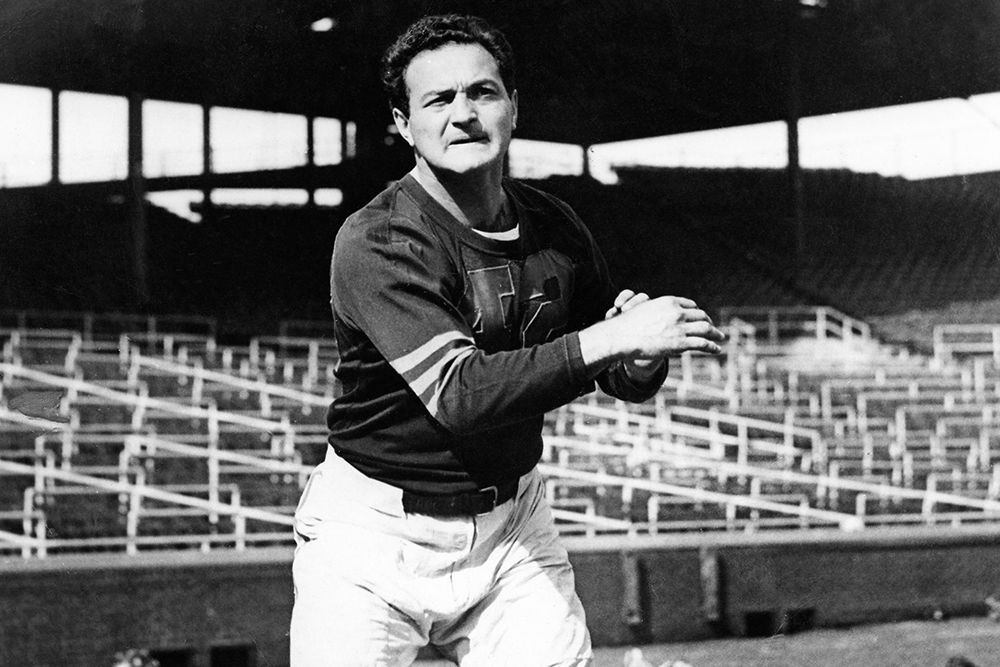Legendary seasons for Sid Luckman, Peyton Manning separated by 70 years
Special to the Pro Football Hall of Fame
(Editor’s note: This article is the fourth in a series looking at quarterbacks’ achievements that have aged well over the past 80 NFL seasons.)
The Pro Football Hall of Fame has enshrined 34 players at the quarterback position: eight categorized as halfback/quarterbacks and 26 as quarterbacks. All but four of those players have taken snaps since 1943.
Two historic passing seasons are the subject of this retrospective: the 80-year anniversary of SID LUCKMAN'S 1943 season and the 10-year anniversary of PEYTON MANNING'S 2013 season.
Although the two quarterbacks’ careers were separated by nearly a half-century (Luckman’s retirement after 1950 and Manning’s arrival in 1998), there are still plenty of similarities to be found.
Common ground
Both quarterbacks are members of the Pro Football Hall of Fame: Luckman enshrined as a member of the Class of 1965 and Manning as a member of the Class of 2021.Both quarterbacks were drafted top two overall: Luckman at No. 2 in the 1939 NFL Draft and Manning No. 1 overall in the 1998 NFL Draft.
Both quarterbacks led the NFL in passer rating three times: Luckman in 1941, 1943 and 1946; Manning in 2004-06.
Both quarterbacks led the NFL in passing yards three times: Luckman in 1943, 1945 and 1946; Manning in 2000, 2003 and 2013.
Both quarterbacks are members of NFL All-Decade Teams: Luckman for the 1940s and Manning for the 2000s.
Since 1943, the two Hall of Famers stretched the limits of the NFL record book in ways only a few others can claim.

The single-season record for passing yards has been set 11 times during that span …
- 2,194 by Sid Luckman (1943)
- 2,938 by SAMMY BAUGH (1947)
- 3,099 by JOHNNY UNITAS (1960)
- 3,723 by SONNY JURGENSEN (1961)
- 3,747 by Sonny Jurgensen (1967)
- 4,082 by DAN FOUTS (1979)
- 4,715 by Dan Fouts (1980)
- 4,802 by Dan Fouts (1981)
- 5,084 by DAN MARINO (1984)
- 5,476 by Drew Brees (2011)
- 5,477 by Peyton Manning (2013)
…and the single-season record for touchdown passes has been set (or tied) nine times:
- 28 by Sid Luckman (1943)
- 32 by Johnny Unitas (1959)
- 32 by Sonny Jurgensen (1961)
- 33 by Y.A. TITTLE (1962)
- 36 by Y.A. Tittle (1963)
- 48 by Dan Marino (1984)
- 49 by Peyton Manning (2004)
- 50 by Tom Brady (2007)
- 55 by Peyton Manning (2013)
Only Luckman (1943), Marino (1984) and Manning (2013) managed to break both records during the same season.
With 2024 marking the 40-year anniversary of Marino’s 1984 season, another retrospective will be in order next year.
For now, let’s unpack Luckman’s and Manning’s historically similar campaigns.
Seven touchdown passes in a single game

When Luckman threw for seven touchdown passes in a 56-7 win over the New York Giants on Nov. 14, 1943, a new single-game record was set.
How difficult was it to throw seven touchdown passes in a single game?
So difficult that nearly 80 years later, the record has never been toppled. It has been matched seven times (six in the NFL, once in the AFL), with no quarterback managing to do so between 1970 and 2012.
That changed Sept. 5, 2013, when the NFL season-opener took place between the defending Super Bowl champion Baltimore Ravens and the team they eliminated in double-overtime in the AFC Divisional Round of the postseason 236 days prior: the Denver Broncos.
Manning got his revenge, completing 27 of 42 passes for 462 yards, seven touchdown passes and zero interceptions as the Broncos defeated the Ravens 49-27.
That set the tone for what was to come, although some have forgotten the adversity Manning battled en route to etching his name into the record books.
Injuries
On Oct. 13, 2013, against the Jacksonville Jaguars, Manning suffered two ankle sprains that would affect his health for the remainder of the season. His performance dipped noticeably between Week 6 and Week 12 as his ankles were further injured against the Colts on Oct. 20 and against the Chargers on Nov. 10.It's easy to forget now considering how dominant Manning's MVP season went on to become, but there was a point when the Broncos weren't sure if he'd be able to play against the Kansas City Chiefs on Nov. 17.
Rick Peters, a specialist with 30 years of experience designing and developing ankle braces, sent the Denver Broncos one of his newest inventions: the Ultra CTS.
“I know that injury ... I don’t think he could have played without that brace,” Peters said. Manning wore it for the rest of the season.
The correlation between Manning’s performance and injury was clearly apparent when breaking down the timeline of his season into three chapters: 1. Healthy, 2. Post-injury and 3. Recovering.
Weeks 1-5: Healthy
• 150-of-198 (75.8%) for 1,884 yards, 20 touchdowns and 1 interception. 136.4 passer rating.
Weeks 6-12: Post-injury
• 155-of-247 (62.8%) for 1,838 yards, 16 touchdowns and 6 interceptions. 96.9 passer rating.
Weeks 13-17: Recovering
• 145-of-214 (67.8%) for 1,755 yards, 19 touchdowns and 3 interceptions. 116.5 passer rating.
Whether or not Manning completely recovered that season is unknown. There is no doubt injuries took their toll as his Hall of Fame career was nearing its final act. We do know he eventually found his groove and continued to dominate late in the 2013 season.
Dominance

Manning’s most impressive game might not have been the seven-touchdown effort against the Ravens in Week 1, but rather the four touchdown passes he threw against the Titans in Week 14.
The Titans’ defense ranked No. 1 in the NFL in 2013 in touchdown passes surrendered, allowing only 15 all season (0.9 per-game).
Prior to playing the Broncos, the Titans’ pass defense had allowed only two touchdown passes over the previous eight games. (Cumulative opponents’ eight-game stats: 149-of-249 for 1,783 yards, two touchdowns and five interceptions.)
Manning completed 39-of-59 passes for 397 yards, four touchdown passes and zero interceptions.
Such domination relative to strength of competition was not unlike what Luckman achieved 70 years prior.
In 1943, the New York Giants pass defense allowed nine touchdown passes in the nine games that didn’t include Luckman on the opposite sideline.
The Championship Game
The proverbial fork in the road between Luckman’s 1943 season and Manning’s 2013 season came on the championship stage.Luckman and the Bears toppled Sammy Baugh and the Washington Redskins 41-21 in the NFL Championship Game.
Luckman himself? Unstoppable — completing 15-of-26 passes for 286 yards, five touchdown passes and zero interceptions.
Manning and the Broncos fell to the Seattle Seahawks 43-8 in Super Bowl XLVIII. His stats: 34-of-49 passing for 280 yards, one touchdown, two interceptions and a successful two-point conversion passing attempt.
Although there’s no way to sugar coat a 35-point loss, it is worth noting that Manning did complete 69% of his passes (70% if you include the two-point conversion) and set a then-Super Bowl record 34 pass completions against one of the most dominant pass defenses of all time.
He also eclipsed, at the time, Tom Brady to become the NFL’s all-time postseason passing leader at 6,589 yards.
Conclusion
Although the two historic passing seasons were separated by seven decades and recorded by quarterbacks from distinct generations, the similarities and statistical accomplishments will link them forever.Luckman retired as the highest-rated passer in NFL history (minimum 300 attempts) at 75.0 and would rank second only to Baugh for all-time in pass completions (904), passing yards (14,686) and touchdown passes (137). He appeared in five NFL Championship Games, winning four (1940, 1941, 1943 and 1946).
Manning retired as the NFL’s all-time leader in passing yards (71,940) and touchdown passes (539) and would rank second only to Brett Favre in pass completions (6,125). He appeared in four Super Bowls, winning two (XLI and 50).
As the 2023 season approaches, another opportunity will present itself for Manning’s single-season records to fall.
 Nearly a decade ago, Manning said “I think it’s a unique thing, and a neat thing, to be a part of NFL history, even though it may be temporary … I personally think that all season records are going down, especially if they go to 18 games …
Nearly a decade ago, Manning said “I think it’s a unique thing, and a neat thing, to be a part of NFL history, even though it may be temporary … I personally think that all season records are going down, especially if they go to 18 games … “Brady will probably break it again next year (2014) or the year after (2015), so we’ll enjoy it as long as it lasts.”
Neither of Manning’s records have been threatened.
To put the magnitude of his numbers into perspective, his 5,477 passing yards and 55 touchdown passes in 15.5 games (he rested the entire second half of the regular-season finale vs. the Raiders and played much of the season injured) would equal 6,007 passing yards and 60 touchdown passes over 17 games.
Reigning NFL MVP Patrick Mahomes led the NFL with 5,250 passing yards and 41 touchdown passes last year.
What Manning did in 2013 and what Luckman did in 1943 will remain preserved forever at the Pro Football Hall of Fame in Canton, Ohio.
Ryan Michael is statistician, sportswriter and contributor to the Pro Football Hall of Fame. You can follow him on Twitter: @theryanmichael .
This article is the fourth of a multi-part series highlighting noteworthy quarterback play over the past 80 seasons. Information from Pro-Football-Reference.com’s database, including its “Play Index Tools,” helped make the research possible.
More of this series
- Analysis: Charlie Conerly’s giant accomplishments hold up as eras pass
- Y.A. Tittle’s journey from San Francisco to New York
- Analysis: An appreciation of Sammy Baugh’s historic 1943 season
- Legendary seasons for Sid Luckman, Peyton Manning separated by 70 years
- Looking back at TB12’s historic 2011 season 12 years later
- Russell Wilson’s decade of dominance in Seattle remains elite
- Roger Staubach’s 1971: The greatest season you’ve never heard about
- Silver anniversary: Randall Cunningham’s solid gold season with Vikings
- 50 years since Unitas’ last pass: Some things you might not know about No. 19
- Race to the top: Brady’s battle with Brees for the NFL’s most hallowed record
- Analysis: Did Andrew Luck exceed hype or fall short?
- Silver anniversary of John’s Elway’s sterling final game
- As cold as ice: Perception of Matt Ryan’s legacy after ‘28-3’
- Cam Newton leads high-flying 2015 Carolina Panthers
- Peyton Manning’s four-year rodeo in Mile High City
- Dan Marino eclipsed long-standing TD record 40 years ago
Pro Football Hall of Fame to commemorate 60th anniversary with multi-day celebration
The Pro Football Hall of Fame will commemorate its 60th anniversary with a series of events not only to celebrate the greatest of the game, but also to recognize the community that has given so much to the Hall.
Pro Football Hall of Fame enshrines Class of 2023
The Pro Football Hall of Fame enshrined it's Class of 2023 on Saturday. The class included cornerback/safety RONDÉ BARBER, coach DON CORYELL, linebacker CHUCK HOWLEY, defensive end/defensive tackle/nose tackle JOE KLECKO, cornerback DARRELLE REVIS, cornerback KEN RILEY, offensive tackle JOE THOMAS, linebacker ZACH THOMAS and linebacker/defensive end DEMARCUS WARE.